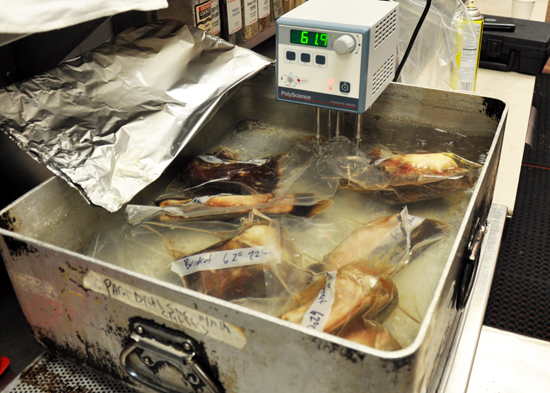Ever have one of those weeks at work where you felt like you constantly under pressureand you couldn’t get away from it — like you were working in a vacuum?

I just had one of the weeks, but no one around here seems to feel very sorry for me. Chef Chris Geualdi and I recently got an assignment from our boss and we knew the pressure was on us, heck it was all around us. We were shipped off to Venice, Italy for a week of training in sous vide technology. We visited Orved, an amazing company in Musile, a small town on the Piave River just 30 km north of Venice. It was a phenomenal time to eat and learn. I’ll tell you more about the food later; first, let's get down to the really fun stuff — sous vide. Since sous vide is likely to become a regular subject on this blog, let’s start with the basics.
What is sous vide?
The term sous vide literally translated means ‘under vacuum’ in French. It refers to food that is sealed in a vacuum packed in food safe bags. The method of vacuum sealing meats was originally developed to help extend their shelf life, but is now commonly used to cook meats also. The term sous vide is often incorrectly used to refer to all types of low-temperature cooking.
Why use sous vide?
Chefs may debate the reasons for preparing foods sous vide — some focus on the tenderness that can be created, others for the purity or concentration of flavor. But the top two reasons that no one can debate are the incredible consistency and precision of the results — with exact times and temperatures items are cooked perfectly every time. It's a way for a chef to know that the chicken is cooked perfectly through every time, leaving nothing to chance (or a distracted line cook). And making sure that an embarrassing medium-rare chicken breast is never returned to the kitchen.
How does it work?
Well, as mentioned there are really two things at work here — the vacuum sealing (sous vide) and then the low-temperature cooking. First, the food is placed in a special heavy-duty, food-safe plastic bag. Then those bags go into a machine with a closed chamber that pumps all the air out of both the bag and the food. This makes the process a great tool for instant marinating and pickling as well as preserving since any surrounding liquid is immediately taken up into the food when the air leaves. The bags are then sealed before the pressure is released from the chamber, creating a permanent, air-tight seal. Next comes the cooking process. There are a number of ways to go about cooking things sous vide, but the most common is to place the sealed bag in precisely controlled water bath. With the help of an immersion or thermal cirulator, the water in the bath is not only maintained at a precise temperature but the water is kept in constant motion to make the cooking more precise. Normal cooking temperatures range between 120˚F and 165˚F though temperatures are normally expressed in Celsius (50˚C to 72˚C). Outside of the thermal circulator, specialized ovens such as the C-Vap or CombiOven which can also precisely control the low temperatures are required for this style of cooking.
Whats next?
Keep an eye on this blog as Chef Chris and I get our hands dirty, armed with this new knowledge and get ready to share it with you.



